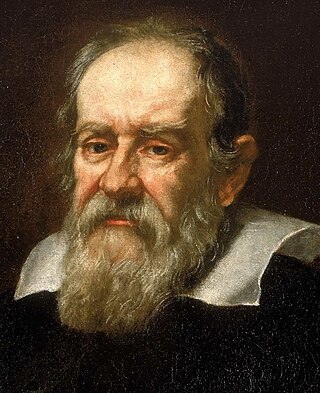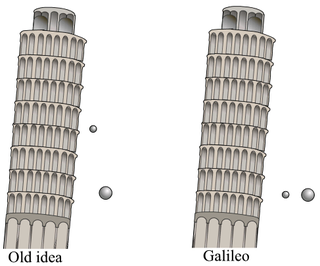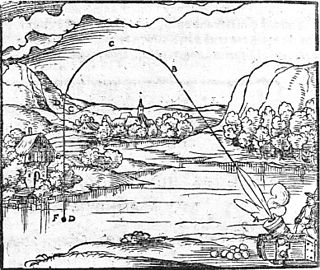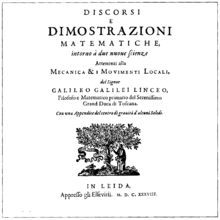
Physics is a branch of science whose primary objects of study are matter and energy. Discoveries of physics find applications throughout the natural sciences and in technology. Historically, physics emerged from the scientific revolution of the 17th century, grew rapidly in the 19th century, then was transformed by a series of discoveries in the 20th century. Physics today may be divided loosely into classical physics and modern physics.
Inertia is the tendency of objects in motion to stay in motion, and objects at rest to stay at rest, unless a force causes its speed or direction to change. It is one of the fundamental principles in classical physics, and described by Isaac Newton in his first law of motion. It is one of the primary manifestations of mass, one of the core quantitative properties of physical systems. Newton writes:
LAW I. Every object perseveres in its state of rest, or of uniform motion in a right line, except insofar as it is compelled to change that state by forces impressed thereon.

Mass is an intrinsic property of a body. It was traditionally believed to be related to the quantity of matter in a body, until the discovery of the atom and particle physics. It was found that different atoms and different elementary particles, theoretically with the same amount of matter, have nonetheless different masses. Mass in modern physics has multiple definitions which are conceptually distinct, but physically equivalent. Mass can be experimentally defined as a measure of the body's inertia, meaning the resistance to acceleration when a net force is applied. The object's mass also determines the strength of its gravitational attraction to other bodies.
Mechanics is the area of mathematics and physics concerned with the relationships between force, matter, and motion among physical objects. Forces applied to objects result in displacements or changes of an object's position relative to its environment.

In physics, gravity (from Latin gravitas 'weight') is a fundamental interaction which causes mutual attraction between all things that have mass. Gravity is, by far, the weakest of the four fundamental interactions, approximately 1038 times weaker than the strong interaction, 1036 times weaker than the electromagnetic force and 1029 times weaker than the weak interaction. As a result, it has no significant influence at the level of subatomic particles. However, gravity is the most significant interaction between objects at the macroscopic scale, and it determines the motion of planets, stars, galaxies, and even light.
The following is a timeline of classical mechanics:
In Newtonian physics, free fall is any motion of a body where gravity is the only force acting upon it. In the context of general relativity, where gravitation is reduced to a space-time curvature, a body in free fall has no force acting on it.

The Dialogue Concerning the Two Chief World Systems is a 1632 Italian-language book by Galileo Galilei comparing the Copernican system with the traditional Ptolemaic system. It was translated into Latin as Systema cosmicum in 1635 by Matthias Bernegger. The book was dedicated to Galileo's patron, Ferdinando II de' Medici, Grand Duke of Tuscany, who received the first printed copy on February 22, 1632.
Galileo's ship refers to two physics experiments, a thought experiment and an actual experiment, by Galileo Galilei, the 16th- and 17th-century physicist and astronomer. The experiments were created to argue the idea of a rotating Earth as opposed to a stationary Earth around which rotated the Sun, planets, and stars.
Galileo's paradox is a demonstration of one of the surprising properties of infinite sets. In his final scientific work, Two New Sciences, Galileo Galilei made apparently contradictory statements about the positive integers. First, a square is an integer which is the square of an integer. Some numbers are squares, while others are not; therefore, all the numbers, including both squares and non-squares, must be more numerous than just the squares. And yet, for every number there is exactly one square; hence, there cannot be more of one than of the other. This is an early use, though not the first, of the idea of one-to-one correspondence in the context of infinite sets.
In physics, mechanics is the study of objects, their interaction, and motion; classical mechanics is mechanics limited to non-relativistic and non-quantum approximations. Most of the techniques of classical mechanics were developed before 1900 so the term classical mechanics refers to that historical era as well as the approximations. Other fields of physics that were developed in the same era, that use the same approximations, and are also considered "classical" include thermodynamics and electromagnetism.

In physics, theories of gravitation postulate mechanisms of interaction governing the movements of bodies with mass. There have been numerous theories of gravitation since ancient times. The first extant sources discussing such theories are found in ancient Greek philosophy. This work was furthered through the Middle Ages by Indian, Islamic, and European scientists, before gaining great strides during the Renaissance and Scientific Revolution—culminating in the formulation of Newton's law of gravity. This was superseded by Albert Einstein's theory of relativity in the early 20th century.
Atomism is a natural philosophy proposing that the physical universe is composed of fundamental indivisible components known as atoms.

Between 1589 and 1592, the Italian scientist Galileo Galilei is said to have dropped two spheres of the same volume but different masses from the Leaning Tower of Pisa to demonstrate that their time of descent was independent of their mass, according to a biography by Galileo's pupil Vincenzo Viviani, composed in 1654 and published in 1717. The basic premise had already been demonstrated by Italian experimenters a few decades earlier.
Aristotelian physics is the form of natural science or natural philosophy described in the works of the Greek philosopher Aristotle. In his work Physics, Aristotle intended to establish general principles of change that govern all natural bodies, both living and inanimate, celestial and terrestrial – including all motion, quantitative change, qualitative change, and substantial change. To Aristotle, 'physics' was a broad field that included subjects that would now be called the philosophy of mind, sensory experience, memory, anatomy and biology. It constitutes the foundation of the thought underlying many of his works.

The theory of impetus is an auxiliary or secondary theory of Aristotelian dynamics, put forth initially to explain projectile motion against gravity. It was introduced by John Philoponus in the 6th century, and elaborated by Nur ad-Din al-Bitruji at the end of the 12th century. The theory was modified by Avicenna in the 11th century and Abu'l-Barakāt al-Baghdādī in the 12th century, before it was later established in Western scientific thought by Jean Buridan in the 14th century. It is the intellectual precursor to the concepts of inertia, momentum and acceleration in classical mechanics.

Galileo di Vincenzo Bonaiuti de' Galilei, commonly referred to as Galileo Galilei or simply Galileo, was an Italian astronomer, physicist and engineer, sometimes described as a polymath. He was born in the city of Pisa, then part of the Duchy of Florence. Galileo has been called the father of observational astronomy, modern-era classical physics, the scientific method, and modern science.
Quaestiones quaedam philosophicae is the name given to a set of notes that Isaac Newton kept for himself during his earlier years in Cambridge. They concern questions in the natural philosophy of the day that interested him. Apart from the light it throws on the formation of his own agenda for research, the major interest in these notes is the documentation of the unaided development of the scientific method in the mind of Newton, whereby every question is put to experimental test.
De motu antiquiora, or simply De Motu, is Galileo Galilei's early written work on motion. It was written largely between 1589 and 1592, but was not published in full until 1890. De Motu is known for expressing Galileo's ideas on motion during his Pisan period prior to transferring to Padua.
Jacques-Alexandre Le Tenneur was a French mathematician who defended Galileo Galilei’s ideas. He corresponded with fellow mathematicians such as Pierre Gassendi, Pierre Hérigone and Marin Mersenne. It is unclear when or where he died but he probably lived from 1610 to 1660.











